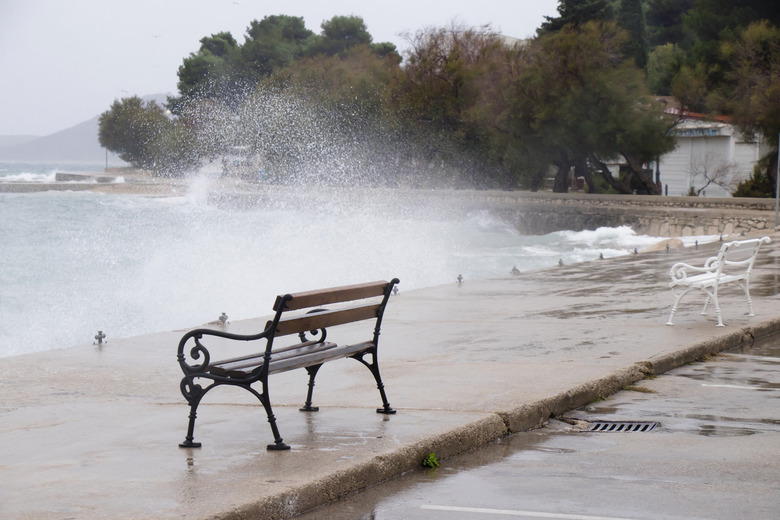Which Types Of Fronts & Air Masses Bring A Hurricane?
Hurricanes are storm systems that feature very large low-pressure systems including a multitude of thunderstorms with rain, lightning, hail and strong winds. To be considered a hurricane, the storm wind must reach speeds greater than 74 mph (119.09 km/h). These storms often develop when a cool air front stalls over warm tropical waters, allowing large amounts of the warm water vapor to be transferred into the air.
Hurricane Conditions
Hurricane Conditions
Hurricanes conditions occur when warm, moist air evaporates from the surface of the ocean and rises quickly. This warm air meets cool air in the higher elevations that causes condensation of the warm air vapor. The condensation turns into storm clouds that make up hurricanes. Hurricanes occur when this cycle persists and more warm moist air is drawn into the storm clouds, transferring additional heat from the ocean surface into the atmosphere. The cycle causes a circular wind pattern in the storm and spirals around a calm center or eye of the storm.
Hurricane Weather Patterns
Hurricane Weather Patterns
Large, low pressure systems carrying cool air collide with the warm winds near the tropical ocean's surface, pushing large amounts of water vapor into the upper elevations. This heightened circulation of warm air causes the upper level wind speeds to increase and storms to develop. High altitude winds pull the warm air away from the center of the storm creating the circular hurricane pattern. Storm winds continue to increase in speed as high-pressure air is drawn into the low-pressure storm center.
Hurricane Categories
Hurricane Categories
Hurricanes are gauged by the wind speed of the storm. Prior to becoming a hurricane, the storm goes through 2 stages: tropical depression and tropical storm. Tropical depressions have winds of less than 38 mph (61.15 km/h), and tropical storm winds reach 39 to 73 mph (62.76 to 117.48 km/h). Upon reaching 74 mph (119.09 km/h), the storm officially becomes a hurricane. The strength of the hurricane is gauged by the wind strength and is broken into 5 categories. Category 1 storms have sustained winds of 74 to 95 mph (119 to 153 km/h) and will produce some damage. Category 2 storms have sustained winds of 96 to 110 mph (154 to 177 km/h) and will cause extensive damage. Category 3 storms have sustained winds of 111 to 130 mph (178 to 209 km/h) and will cause devastating damage. Category 4 storms have sustained winds of 131 to 155 mph (210 to 249 km/h) and will cause catastrophic damage. Category 5 is the highest category of hurricane with sustained winds greater than 155 mph (249 km/h). Category 5 storms cause catastrophic damage and probable loss of life.
Hurricane Seasons
Hurricane Seasons
Hurricane seasons vary for different parts of the world. The main areas affected by hurricanes are the Atlantic Ocean, South American eastern and northern coasts and North American eastern and southern coasts. June 1 is the official start date of the hurricane season in the Atlantic Ocean. North America's peak season normally lasts from August through October.
Cite This Article
MLA
Travis, Allison. "Which Types Of Fronts & Air Masses Bring A Hurricane?" sciencing.com, https://www.sciencing.com/types-air-masses-bring-hurricane-8177904/. 22 November 2019.
APA
Travis, Allison. (2019, November 22). Which Types Of Fronts & Air Masses Bring A Hurricane?. sciencing.com. Retrieved from https://www.sciencing.com/types-air-masses-bring-hurricane-8177904/
Chicago
Travis, Allison. Which Types Of Fronts & Air Masses Bring A Hurricane? last modified March 24, 2022. https://www.sciencing.com/types-air-masses-bring-hurricane-8177904/
